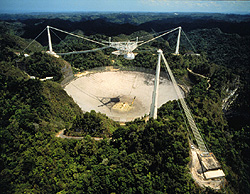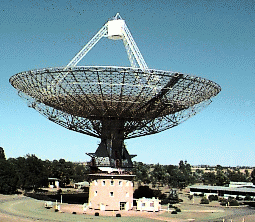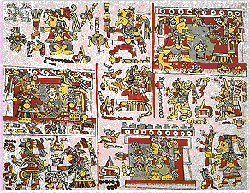On April 8, it will
be exactly four decades since radio astronomer Frank Drake swung
an antenna skyward hoping to find something other than the faint
hiss of gas and galaxies. Drake was searching for a narrow-band
whistle, a signal from a distant civilization.
His pioneering experiment
used a small radio telescope in Green Bank, West Virginia. Since
then, the search for extraterrestrial intelligence (SETI) has progressed
to vastly improved equipment. Nonetheless, the dismaying fact is
that none of the small coterie of scientists pursuing SETI have
yet managed to find a single, confirmed chirp from the dark depths
of the cosmos. The aliens, who I feel confident are out there, remain
frustratingly out of sight.
But not out of mind.
Today’s SETI experiments are some 100 trillion times better
than Drake’s original search. In the next decade, new technologies
and new telescopes will improve the capabilities for finding celestial
societies by another factor of a thousand. While no one can be sure
of success, many astronomers involved in these efforts, including
me, suspect that we could soon have our first detection of an alien
signal.
Preparing for
Contact
If so, what happens next? Is
humankind prepared to learn that the fictional aliens of Hollywood
have living, unpredictable counterparts in the local galactic neighborhood?
Would the news galvanize people with the excitement of a major discovery
– or, alternatively, sound the alarms of fear?
It all depends. Our reaction
hinges on the nature of the detection, the message (if any), and
how the news is spread. Some of this is predictable, but much is
not. So perhaps we shouldn’t worry about it. After all, did
fifteenth century Spaniards wring their hands over the possibility
that Columbus might discover a new world, precipitating panic in
the streets of Segovia? Hardly. More to the point: would the wringing
of hands have helped?
In the case of SETI, some researchers
believe it would. The reaction to a SETI detection has been
considered. After all, SETI differs in a fundamental way from Columbus’s
voyage. The search is a deliberate investigation into the unknown.
Discovery of a new world – an alien civilization – would
not be an unforeseen by-product of SETI, but its primary intention.
Consequently, sociologists, psychologists and others have produced
a considerable body of literature describing what might happen and
prescribing what should be done in case of success.
The SETI Declaration

PhotosToGo
Cultures
have collided before - ruins from the Mayan civilization.
|
In addition, the SETI researchers themselves have adopted an informal
protocol that outlines actions to be taken by the discoverers. This
protocol, A Declaration of Principles Concerning Activities Following
the Detection of Extraterrestrial Intelligence, assumes that our
first tip-off of alien presence will be a radio (or optical) fingerprint:
a signal from space.
This is the type of
search that I’m involved in. It is, of course, a direct descendant
of Drake’s 1960 experiment. My employer, the SETI Institute,
is currently using the 1000-foot diameter Arecibo Radio Telescope
in Puerto Rico to examine approximately a thousand nearby star systems
for alien transmissions. This type of reconnaissance makes a lot
of sense. It doesn’t involve the assumption that the aliens
are mounting a prodigious effort to get in touch. If a civilization
100 light years distant has an antenna the size of Arecibo, and
beams a signal straight towards us, then a paltry 10 kilowatt transmitter
will be sufficient to catch our attention.

NASA The
Arecibo Radio Telescope - searching for extra terrestrial
life
|
Finding a signal may
be our best hope for locating cosmic confreres. Anticipating this,
the Declaration defines a series of steps that researchers
should undertake to verify that the broadcast is truly extraterrestrial,
and then it urges a rapid announcement to the astronomical community,
to local governments and to the public. In other words, if our radio
telescopes pick up ET, you’ll quickly be reading about it in
the papers. And because so many among the populace are convinced
that aliens exist (even to the point of being blasé), there’s
little chance of rioting in the streets.
Cover-up?
Mind you, some people,
particularly in the United States (where belief in government conspiracy
is considered a mark of political sophistication), are sure that
a SETI detection would be hushed up rather than let loose on a labile
public.
I am amused by this
paranoia. Most SETI experiments, including all of the US efforts,
are privately funded, and the government has no involvement. More
to the point: there is no policy of secrecy within the research
community, which means that – even as an interesting signal
is being received – the scientists will be excitedly e-mailing
friends and relatives.
I’ve seen this
process in action on a few occasions, when our experiment has been
briefly fooled by picking signals from space probes. These messages
from robots that we’ve sent to the edge of the Solar System
have many of the hallmarks we expect from an alien signal. While
my colleagues and I were looking wild-eyed at the computers, I noted
that the government showed no interest. The media, on the other
hand, did.
And even those who
believe in a government conspiracy over UFOs could hardly claim
the same for SETI. A signal from space is not something you can
stack up in a secret hangar or hide behind six layers of barbed
wire in the desert. A SETI signal can be easily confirmed and will
be impossible to hide. There was a parallel in the seventeenth century.
When clerics forced Galileo to desist from publishing his discoveries
of Jupiter’s large moons (a strong proof that the Earth was
not the center of the Universe), he reputedly swallowed hard and
muttered that "still, it moves." In other words, the evidence
for his discovery was sitting in the sky awaiting confirmation by
anyone with a cheap telescope and a few minutes’ time. The
same is true of a SETI signal: the word will be out, and fast.

Australia National Telescope Facility
The
Parkes Telescope in Australia is part of SETI's SERENDIP
programme
|
Alien hardware
Of course, it’s
also conceivable that we will find not a signal, but alien artifacts.
Imagine that Hubble or some other large telescope accidentally captures
an image of the exhaust radiation from an interstellar rocket. Or
perhaps we will trip over colossal feats of astro-engineering involving
the rearrangement of an alien society’s entire planetary system.
Such discoveries would undoubtedly be reported just as quickly as
a SETI signal. The consequences, to my mind, would also be similar:
a mammoth news story, inspiring follow-up research by just about
every astronomer on the planet.
If the artifact were
right on our doorstep, however, it would trigger a different response.
We might – as suggested by Arthur C. Clarke - discover a purpose-built
monolith on the Moon. Another intriguing possibility is that we
could find a time capsule at one of the Lagrangian points –
gravitational dead spots in the Earth-Moon system where an alien
memento could float in endless space storage. Perhaps we’ll
suddenly uncover an interstellar probe hanging out in our Solar
System, or maybe the aliens will actually land at 10 Downing Street
and demand satisfaction.
Such scenarios are
entirely different (and, to my mind, enormously less probable) than
the SETI success that I am considering here. They would provide
physical evidence we could cart to the lab and – in the case
of alien visitation – might confront us with a lethal threat.
Some of the social researchers who consider what will happen if
we find ET point to historical analogs such as Orson Welles’s
1938 War of the Worlds radio broadcast, which panicked many
people on the US East Coast. Such an apocalyptic reaction might
follow a close encounter of the physical kind. But a microwave radio
signal or a flashing infrared light beam, reaching us from hundreds
or thousands of light-years away, is no reason to board the windows
and head for the hills.
Instead, we’ll
slew all the telescopes we can in the direction of the incoming
signal. Every observatory that can aim its instruments ET’s
way will do so. We’ll quickly know something about the type
of star system that houses this newly found society, as well as
its distance. In addition, we can hope to measure slow shifts in
the frequency of the incoming signal, caused by the Doppler effect
as the transmitter moves. Assuming ET is broadcasting from a planetary
surface, we’ll be able to compute the length of the alien planet’s
day, and its year.

SETI
The
mesage sent out from the Arecibo Telescope - could you decode
it?
|
Message in
a radio wave
All of this information
will be exciting, yes, but what would really knock our hosiery off
is to know what the aliens are saying. That requires additional
work beyond detection. To make them more sensitive, the SETI receivers
add up the incoming radio waves over fixed period – the time
constant – which is typically a second or so. As a result,
any variations in the signal that are faster than once per second
are smoothed out and lost. A terrestrial TV signal, for example,
varies about five million times per second, so if your home set
were to have a one-second time constant, you’d find the telly
a bore (or perhaps I should say, more of a bore). The screen would
be a slowly changing, gray wash of light.
Simply shortening the
receivers’ time constant isn’t the trick, however. That
just weakens the signal and makes it noisier. What we need is to
boost the signal first, so we can still detect it even with a shorter
time constant. In practice, that means SETI researchers will have
to build far larger telescopes than they have today - perhaps ten
thousand times larger. That’s currently a financial impossibility,
but if an alien signal is detected I fully expect that the money
will be found to construct this super-instrument.
Suppose it happens.
Suppose that we have not only tuned in to ET’s broadcast, but
we are happily downloading the bits that constitute the message.
These bits will be recorded and distributed for analysis. After
years of work, either we will succeed in figuring them out, or we
won’t.
It’s probably
realistic to assume that we will comprehend the aliens only if they
are broadcasting deliberately, trying to communicate with other
worlds. They could be engaged in altruistic efforts either to enlighten
their neighbors or simply get in touch with young, technological
societies such as our own. In that case they’ll devise a message
that can be decoded fairly straightforwardly.
Since it’s overwhelmingly
likely that any civilization we detect will be technologically far
older than our own, the message would be of great interest. The
aliens could allow us to short-circuit thousands of years of research
into physics, astronomy, and chemistry, and tunnel our way into
a far more sophisticated future. This could be compared to the rediscovery
of classical science during the Renaissance, but would be of much
greater magnitude. (Mind you, this windfall of knowledge will impose
certain burdens. Scientists, for example, will suddenly be confronted
with answers to research problems that have consumed their entire
careers. These earthly scientists may not be entirely gratified
to yield their chance for a Nobel Prize to the aliens!)

Department of Education, Mexico
A
Mayan Codex - a cryptological puzzle from the past
|
Such a sudden discovery
of knowledge is possible, and it’s an exciting thought. But
it’s also conceivable – and I personally think more probable
– that the message will be difficult and perhaps impossible
to decode. Imagine if the classical Greeks were given the bits belched
out by a modern telecommunications satellite. The Greeks were not
dumb, but they wouldn’t get very far in understanding this
torrent of information.
The same could well
happen to us. Imagine everyone from professional cryptographers
to amateurs with a flair for puzzles taking a crack at understanding
the hieroglyphics from space. The aliens’ message would become
the equivalent of a Mayan Codex or the Dead Sea Scrolls. Centuries
of human effort might be expended in an attempt to understand this
cosmic riddle beamed our way from a society we can never meet. When
the headlines of the initial discovery are only a distant memory,
humankind might still be busying itself with the message.
The signal is
the message
Such thoughts are quite
speculative – and they are also, in some sense, irrelevant.
The detection of an alien civilization will certainly be the biggest
news story of all time. And it will be a lasting story, both because
researchers will continue searching for the message contained within
the signal and because it will heighten the hunt for other signals.
But to paraphrase Marshall McCluhan, the signal is the message.
For a million years, humans have lived on this planet surrounded
by a bubble of isolation. We have seen the Universe, like a vast
and intricate construction, stretching billions of light-years in
all directions. We have not, as yet, found any inhabitants.
But if SETI someday
becomes a discovery, rather than an experiment, the bubble will
burst, and we will suddenly share the cosmic stage with myriad others.
It is hard to imagine a greater metamorphosis.
Copyright
(c) FirstScience.com
